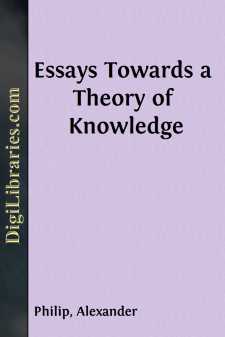Categories
- Antiques & Collectibles 13
- Architecture 36
- Art 48
- Bibles 22
- Biography & Autobiography 813
- Body, Mind & Spirit 142
- Business & Economics 28
- Children's Books 14
- Children's Fiction 11
- Computers 4
- Cooking 94
- Crafts & Hobbies 4
- Drama 346
- Education 46
- Family & Relationships 57
- Fiction 11829
- Games 19
- Gardening 17
- Health & Fitness 34
- History 1377
- House & Home 1
- Humor 147
- Juvenile Fiction 1873
- Juvenile Nonfiction 202
- Language Arts & Disciplines 88
- Law 16
- Literary Collections 686
- Literary Criticism 179
- Mathematics 13
- Medical 41
- Music 40
- Nature 179
- Non-Classifiable 1768
- Performing Arts 7
- Periodicals 1453
- Philosophy 64
- Photography 2
- Poetry 896
- Political Science 203
- Psychology 42
- Reference 154
- Religion 513
- Science 126
- Self-Help 84
- Social Science 81
- Sports & Recreation 34
- Study Aids 3
- Technology & Engineering 59
- Transportation 23
- Travel 463
- True Crime 29
Essays Towards a Theory of Knowledge
by: Alexander Philip
Categories:
Description:
Excerpt
TIME AND PERIODICITY
We can measure Time in one way only—by counting repeated motions. Apart from the operation of the physical Law of Periodicity we should have no natural measures of Time. If that statement be true it follows that apart from the operation of this law we could not attain to any knowledge of Time. Perhaps this latter proposition may not at first be readily granted. Few, probably, would hesitate to admit that in a condition in which our experience was a complete blank we should be unable to acquire any knowledge of Time; but it may not be quite so evident that in a condition in which experience consisted of a multifarious but never repeated succession of impressions the Knowledge of Time would be equally awanting. Yet so it is. The operation of the Law of Periodicity is necessary to the measurement of Time. It is by means, and only by means, of periodic pulsative movements that we ever do or can measure Time. Now, apart from some sort of measurement Time would be unknowable. A time which was neither long nor short would be meaningless. The idea of unquantified Time cannot be conceived or apprehended. Time to be known must be measured.
Periodicity, therefore, is essential to our Knowledge of Time. But Nature amply supplies us with this necessary instrument. The Law of Periodicity prevails widely throughout Nature. It absolutely dominates Life.
The centre of animal vitality is to be found in the beating heart and breathing lungs. Pulsation qualifies not merely the nutrient life but the musculo-motor activity as well. Eating, Walking,—all our most elementary movements are pulsatory. We wake and sleep, we grow weary and rest. We are born and we die, we are young and grow old. All animal life is determined by this Law.
Periodicity—generally at a longer interval of pulsation—equally affects the vegetal forms of life. The plant is sown, grows, flowers, and fades.
Periodicity is to us less obvious in the inanimate world of molecular changes; yet it is in operation even there. But it is more especially in the natural motions of those so-called material masses which constitute our physical environment that Periodicity most eminently prevails. Indeed it was by astronomers that the operation of this Law was first definitely recognised and recorded. Periodicity is the scientific name for the Harmony of the Spheres.
The two periodic motions which most essentially affect and concern us human beings are necessarily the two periodic motions of the globe which we inhabit—its rotation upon its axis which gives us the alternation of Day and Night, and its revolution round the Sun which gives us the year with its Seasons. To the former of these, animal life seems most directly related; to the latter, the life of the vegetal orders. It is evident that the forms of animal life on the globe are necessarily determined by the periodic law of the Earth's diurnal rotation. This accounts for the alternations of waking and sleeping, working and resting, and so forth....


